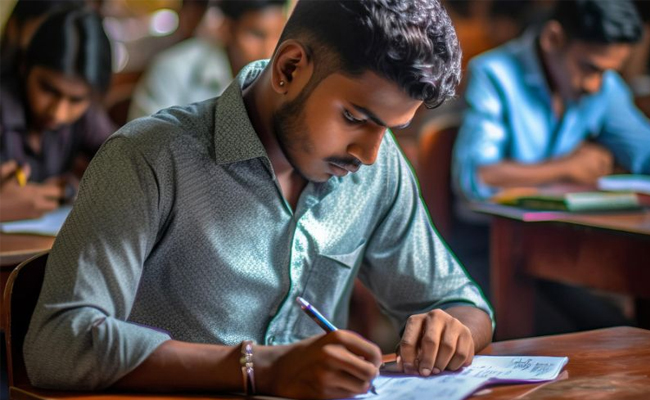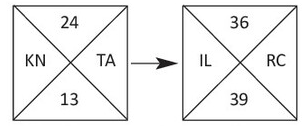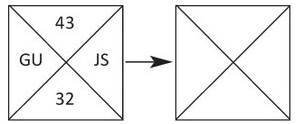Bit Banks and Model Questions for Reasoning in Bank Exams

Model Questions
Directions (Q.No.1-5): Study the following information carefully and answer the questions given below.
Certain number of people was seated in a linear row facing north. One of them was seated at the end. Information about some of them is known. There were not more than 13 people. At least six people were seated between P and U where P was to the right of U. V was to the immediate right of S. T was seated second from the right end of the row. The number of people to the left of Q was more than twice the number of people to the right of Q. Only one person was seated between R and S. There were not more than 5 people sitting between R and Q. R was not seated adjacent to U. No three people mentioned were sitting together.
1. How many people were seated in the row?
a) 8 b) 12 c) 10 d) 11
e) Cannot be determined
2. Who was seated second to the left of R?
a) P b) Q c) U
d) No body e) Data insufficient
3. How many people were seated between Q and S?
a) 3 b) 5 c) 7 d) 8
e) Cannot be determined
4. What is the position of T with respect to U?
a) Second to the right
b) Tenth to the right
c) Fourth to the left
d) Immediate right
e) Immediate left
5. How many people were seated to the left of S?
a) 6 b) 4 c) 9
d) 3 e) 7
☛Follow our YouTube Channel (Click Here)
Directions (Q.No.6-10): Study the following information carefully and answer the questions given below.
Eight persons A, B, C, D, E, F, G and H went to a conclave. It was seen that each person was of a different age. The partial sequence of their ages is as follows:
___>___> F >___ >___>___> __ (39) (27) (23) D > ___
They were seated in a straight row facing the North. The partial arrangement is shown below:
___ B ___ ___ ___ ___ ___ G
(25) (36)
The numbers shown in the brackets denote age.
» The person aged 31 was seated 3rd to the left of the one who was aged 27.
» B was aged more than G.
» The person who was 39 years old was seated 2nd to the left of F
» E was the 2nd eldest person and was seated to the immediate right of C.
» The person aged 23 was to the immediate right of the one who was aged 22
» A was seated 3rd to the left of the one who was 19 years old
» D was not the eldest.
6. What was the age of the person who was at the extreme left end of the row?
a) 31 b) 19 c) 22 d) 39 e) Cannot be determined
7. What was the difference between the age of A and C?
a) 1 year b) 2 years
c) 3 years d) 4 years
e) 9 years
8. Who among the following was seated to the immediate left of D?
a) A b) E c) F
d) B e) H
9. Who among the following was the 3rd youngest person?
a) D b) B c) C
d) A e) F
10. If all the digits at odd positions in the number "324846237" are changed to previous digit in the number series and all the digits at even positions are changed to next digit in the number series, then which digit appears more than twice in the number thus formed?
a) More than one such digit is there
b) 7 c) 2 d) 3
e) No such digit is there
☛ Follow our Instagram Page (Click Here)
Directions (Q.No.11-15): Study the information carefully and answer the questions given below.
Six people were born in different years with the current base is taken as 2018. None of them is older than 90 years old. They like different colours Red, Orange, Green, Blue, Black and Yellow.
A was born in the year 1981. The difference of age between A and C is 23 years. B's age is sum of the digits of the year in which C was born. The one who likes Blue colour is 6 years elder to B. The one who likes green colour is just younger than F. F's age is either the last two digits or reverse of the last two digits of the year in which the person who likes Blue colour was born. The difference between the age of D and the one who likes Green colour is 25 years. D is older than E. F is not the eldest. The one who likes Red colour is just elder than the one who likes Black colour. C does not like Orange colour.
Note - If mentioned the last two digits or reverse of the last two digits of the year in which a person is born can be the age of some other person. (Like A is born in 1943 and age of b is denoted by the last two digits of the birth year of A. Then B's age will be either 34 or 43).
11. Who among the following likes Orange colour?
a) A b) D c) E
d) B e) None of these
12. Who among the following is the eldest?
a) A b) D c) C
d) E e) None of these
13. Which of the following combination is true?
a) A - 1981 - Black
b) B - 2012 - Blue
c) C - 2006 - Yellow
d) F - 1958 - Black
e) None of these
☛ Join our WhatsApp Channel (Click Here)
14. Which of the following statement is correct?
a) A is three years younger than the one who likes Black
b) C is the eldest
c) E likes Blue colour
d) E is born before A
e) All are correct
15. In which of the following year F was born?
a) 1995 b) 1958
c) 1956 d) 2004
e) None of these
Directions (Q.No.16-20): Study the following information carefully and answer the questions given below.
Eight persons P, Q, R, S, T, U, V, W are sitting around a rectangular table but not necessarily in the same order. Those who are sitting next to each have different distance from each other. Each of them facing towards the center. Some of them are sitting at the corners while some are sitting on the side of the table. The area of the rectangular table is 540m2. The length of the table is 7m more than the breadth of the table. R sits at one of the corners of the table. T sits second to the left of R. P is sitting at a distance of 14m from T. Only two persons sit between P and Q. The distance between R and U is twice of the distance between R and V. W faces R. P sits immediate right of W and at a distance of 13m, Neither Q nor S is an immediate neighbour of R. The distance between R and U is 2m more than the distance between P and T. U is not an immediate neighbour of T. The distance between Q and W is equal to the distance between R and U. The distance between Q and S is half of the distance between V and T. T does not sit at the corner of the table.
16. What is the total distance between V and W?
a) 40 m b) 15 m c) 24 m d) 39 m e) 49 m
17. Who among the following sits second to the left of Q?
a) T b) W c) V d) P e) R
18. Which of the following is not true regarding U?
a) U sits second to the left of S
b) The distance between U and V is 24 m
c) W sits third to the right of U
d) P is an immediate neighbour of U
e) All are correct
19. How many persons sits between T and U when counted from the left of U?
a) Three b) One c) No one
d) Four e) Two
20. What is the position of P with respect to S?
a) Third from the right
b) Second from the left
c) Second from the right
d) Fourth from the left
e) None of these
Directions (Q.No.21-23): Study the following data carefully and answer the following given questions.
In a family, there are ten members A, B, J, K, L, N, P, Q, R and T. J is married to K. R is daughter of P. T is wife of N. A is paternal aunt of B. K is paternal aunt of R. Q is niece of A. N is son of J. T has two daughter. L is mother of R. Q and B are granddaughter of J. Each child has either both their parents alive or none alive.
21. How many female members are there in the family?
a) 5 b) 6 c) 7 d) 3 e) 4
22. Which of the following is true?
a) J is brother of P
b) T is sister of R
c) Q is mother of R
d) A is sister of L
e) R is niece of K
23. How many generations and couples are there in the family?
a) 2, 3 b) 3,3 c) 3,2
d) 1, 3 e) 2, 1
Directions (Q.No. 24- 25): Study the following example based on corresponding conditions:

i) If the box contains number
a) And the number is even then multiply the number by 1.5
b) And the number is odd then multiply the number by 3
ii) If the box contains letter/s then
a) Replace vowel by its 2nd next letter as per English alphabets
b. Replace consonant by its 2nd pervious letter as per English alphabets
Apply the conditions to the given input and answer the following questions.

24. 32 will be replaced by ?
a) 64 b) 96
c) 16
d) 48 e) 23
25. U and S will be replace by ____ respectively
a) W and U
b) S and U
c) W and Q d) S and Q
e) None of these
☛ Join our Telegram Channel (Click Here)
Key
1) b 2) c 3) a 4) b 5) b
6) d 7) d 8) c 9) d 10) d
11) d 12) b 13) d 14) c 15) b
16) d 17) e 18) d 19) e 20) c
21) c 22) e 23) b 24) d 25) c
Tags
- Bank Exams
- bit banks for reasoning
- previous and practice questions for bank exams
- reasoning for bank exams
- Competitive Exams
- bank exams preparations
- practice questions and bit banks for banks
- bank exams preparation
- bit banks for bank exams preparations
- Education News
- Sakshi Education News
- Reasoning questions




















